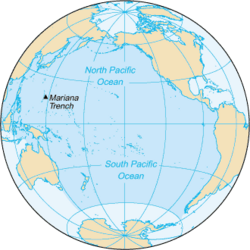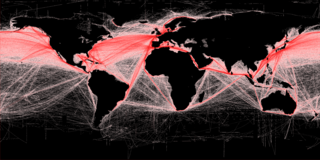Science: An Elementary Teacher’s Guide/Oceans

Introduction
[edit | edit source]Most of the water on Earth is in the oceans, therefore salty The small percent of fresh water is contained in:
- Atmosphere (Water Vapor)
- Lakes/Rivers
- Ice caps/Glaciers
- Ground water
71% of the Earth’s surface is covered by ocean water. The oceans contain 97% of the earth’s water. All the oceans and seas are actually one continuous body of water.
The Major Oceans
[edit | edit source]Earth has four major oceans Pacific, Atlantic, Arctic, and Indian ocean. Together they cover more than 70 percent of the Earth's surface. Many countries including, United States, now recognize the Southern Antarctic Ocean as the fifth major ocean. These oceans are bordered by a variety of seas, which together form the remainder of the ocean-covered portion of the Earth.
1. Pacific Ocean
The Pacific Ocean is the largest body of salt water on the face of the earth. It contains the greatest surface measure of water present as well as containing the Mariana Trench, the deepest point in the earths crust found by man at approximately 36,069 feet deep.
- Largest(1/3 of total ocean surface)
- Deepest (average depth 12,900 ft)

The area and volume of the Pacific Ocean are greater than the Atlantic and Indian combined.
A sea is a part of an ocean that is nearly surrounded by land. The Mediterranean Sea, Arctic Sea and Black Sea are really part of the Atlantic Ocean.
2. Atlantic Ocean
The Atlantic is the second largest body of water on earth, containing the Bermuda Triangle, a notorious area known for mysterious shipwrecks and lost vessels. It also contains the Atlantic Ridge, a 10,000 mile long underwater mountain ridge.
- 1/4 of Earths surface
- average depth of 11,700 ft

3. Indian Ocean
This ocean is the third largest on earth, and is speculated to provide around 40 percent of the worlds crude oil. It is also considered a closed ocean given that it is landlocked to its north by Asia, unlike the other oceans of earth.
- 1/8 of Earths surface
- South of Asia & between Africa & Australia

4. Arctic Ocean
This is the smallest ocean in the world, as well as being the shallowest, though there is argument on the part of some oceanographers to call it the Arctic Mediterranean Sea.
- caps North Pole
- Almost completely covered by ice
- No land mass under ice of Arctic Ocean

Importance of Oceans
[edit | edit source]Importance of Ocean Travel and Transport
[edit | edit source]
This is visualized very nicely on this page.
Ecological importance of oceans
[edit | edit source]Food and economic benefits of healthy oceans
[edit | edit source]- Oceans affect all living things—even those far from the shore.
- Oceans provide a place for many organisms to live.
- Oceans are the lifeblood of planet and Earth and humankind. They flow over nearly three-quarters of our planet, and hold 97% of the planet's water. They produce more than half of the oxygen in the atmoshpehere, and absorb the most carbon from it.
Ocean Features
[edit | edit source]Gases in Oceans
[edit | edit source]- The most abundant gases in ocean water are nitrogen, carbon dioxide and oxygen.
- The amounts of these elements vary with depth. They are more abundant at the ocean’s surface where sunlight causes more plant life.
Continental Shelf
[edit | edit source]- The continental shelf is the gradually sloping end of a continent that extends under the ocean.
- The ocean covering the continental shelf can be as deep as 350 m.
- Large mineral, oil and natural gas deposits are found here.
Most productivity is found here which is why it is very important for fisheries because they are able to capture more sea animals in the continental shelf.
Continental Slope
[edit | edit source]- At the edge of the continental shelf, the ocean floor plunges steeply 4 to 5 kilometers.
- The continental slope extends from the outer edge of the continental shelf down to the ocean floor.
External Links
[edit | edit source]Video from National Park Service about Ocean Ecology
Water
[edit | edit source]The most abundant element in the air is nitrogen but the most abundant element on earth is oxygen. Water contains most of the Earth's oxygen is the most abundant substance on the planet covering more than 70 percent of the Earth's surface. There is a global abundance of water getting the right amounts to the right places and in the right form is a constant struggle in many parts of the world.
Mountains in the Oceans
[edit | edit source]The ocean floor actually consists of mountains and valleys. The tops of most of the mountains are still far beneath the ocean surface some of them pierce the surface to form islands as the Hawaiian Islands, West Indies, and the Aleutian Islands.
-
Caption1
Deposits Collect
[edit | edit source]When rain falls on land many minerals are dissolved and carried to the oceans by rivers and streams. This process has been repeated over millions of years. Which has resulted in vast quantities of salt, gold, and other minerals being dissolved in seawater.
Temperatures Vary
[edit | edit source]Seawater varies greatly in temperature warmer at the surface and near the equator. At the equator water deep in the ocean can be cold at times approaching freezing temperature.
Constant Circulation
[edit | edit source]The water at ocean surface is constantly moving due to the surface is constantly moving due to the force of winds blowing on the water the rotation of the earth. Currents of huge masses of water are affected by the outlines of continental shore lines and by the depth and shape of the ocean floor.
Soil
[edit | edit source]Is the weathered portion of the Earth's crust. Consists of rock material that has been broken up to a fine consistency through natural weathering process and organic matter which is the decayed remains of dead plant and animals. The soil is constantly threatened by erosion is the degradation of lands through forces of water wind and gravity.



